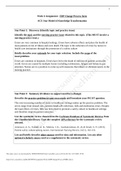Exam (elaborations)
NUR 2063 Pathophysiology Exam 2: NUR 2063 Pathophysiology Exam 2 Study Guide: Updated Solution
- Course
- NUR 2063
- Institution
- Rasmussen College
Gastritis (Ans - an inflammation of the stomachs mucosal lining. It can involve the entire stomach or a region. Manifestations: Include indigestion, heartburn, epigastric pain, abdominal cramping, nausea, vomiting, anorexia, fever, and malaise. Hematemesis and dark, tarry stools can indic...
[Show more]












